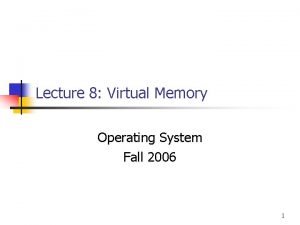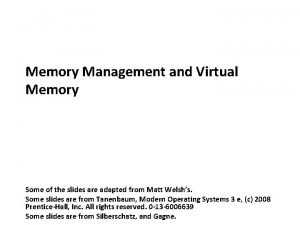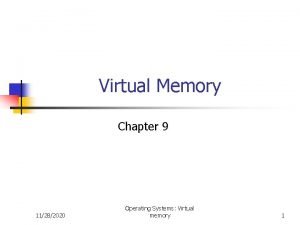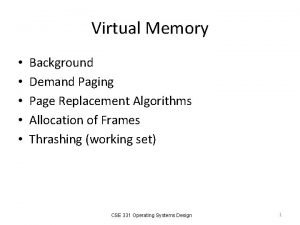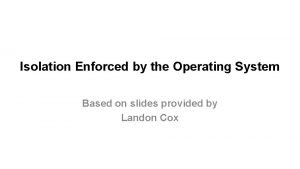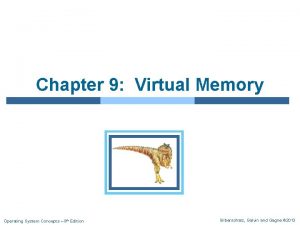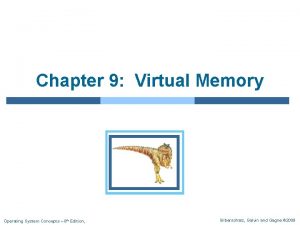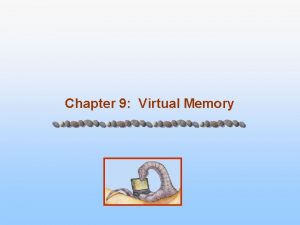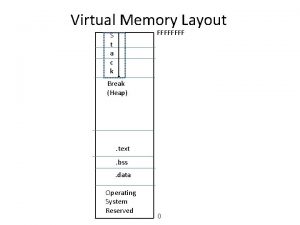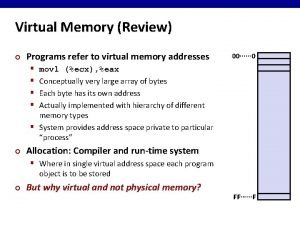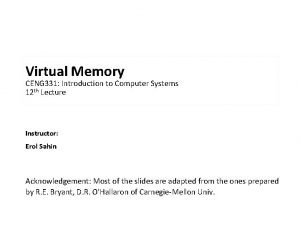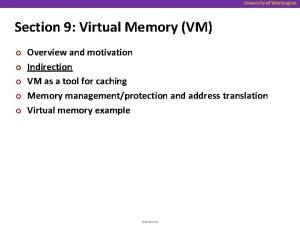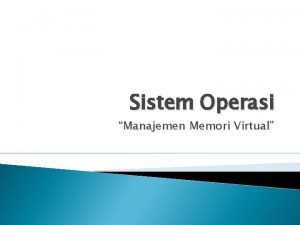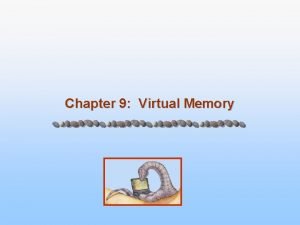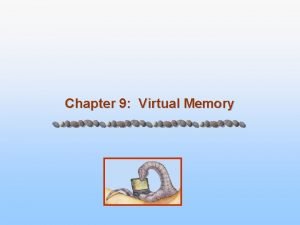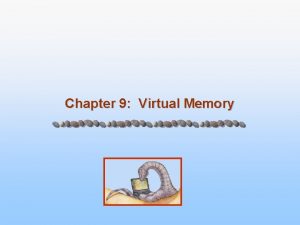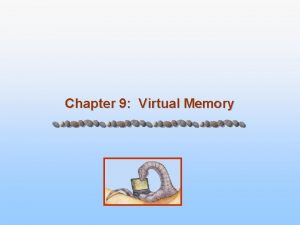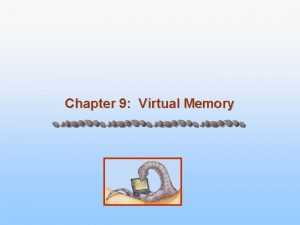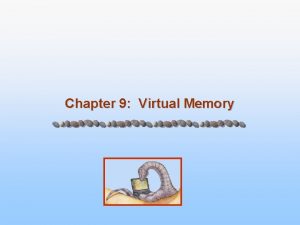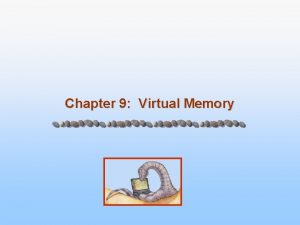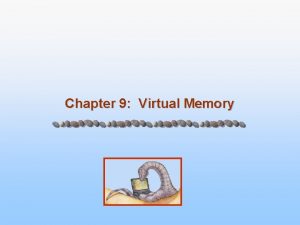Chapter 8 Virtual Memory Key points in Memory






































- Slides: 38

Chapter 8 Virtual Memory

Key points in Memory Management 1) Memory references are logical addresses dynamically translated into physical addresses at run time 2) A process may be broken up into pieces that do not need to located contiguously in main memory

Execution of a Process in Virtual Memory • Only pieces of process that contains the logical address is brought into main memory – Operating system issues a disk I/O Read request – Another process is dispatched to run while the disk I/O takes place – An interrupt is issued when disk I/O complete which causes the operating system to place the affected process in the Ready state



Implications of this new strategy • More processes may be maintained in main memory • A process may be larger than all of main memory

Real and Virtual Memory • Real memory – Main memory, the actual RAM • Virtual memory – Memory on disk

Thrashing • A state in which the system spends most of its time swapping pieces rather than executing instructions. • To avoid this, the operating system tries to guess which pieces are least likely to be used in the near future. • The guess is based on recent history

Paging • Each process has its own page table • Each page table entry contains the frame number of the corresponding page in main memory • Two extra bits are needed to indicate: – whether the page is in main memory or not – Whether the contents of the page has been altered since it was last loaded

Paging Table

Segmentation Table

Address Translation

Page Tables • Assume that a process have up to 231 = 2 GB of virtual memory. • Let Page Size = 29 = 512 bytes • So Page Table will have 222 entries. • Assume that the memory size is 8 GB=233 • So we have 224 frames and we need 24+2=26 bits for each entry in page table. • Therefore the page table size is 26* 222 bits= 3. 25* 222 bytes = 13 MB

Page Tables • Page tables are also stored in virtual memory • When a process is running, part of its page table is in main memory

Two-Level Hierarchical Page Table

Address Translation for Hierarchical page table

Page tables grow proportionally • A drawback of the type of page tables just discussed is that their size is proportional to that of the virtual address space. • An alternative is Inverted Page Tables

Translation Lookaside Buffer • Each virtual memory reference can cause two physical memory accesses – One to fetch the page table – One to fetch the data • To overcome this problem a high-speed cache is set up for page table entries – Called a Translation Lookaside Buffer (TLB) – Contains page table entries that have been most recently used

TLB Operation • Given a virtual address, – processor examines the TLB • If page table entry is present (TLB hit), – the frame number is retrieved and the real address is formed • If page table entry is not found in the TLB (TLB miss), – the page number is used to index the process page table – The TLB is updated to include the new page entry

Translation Lookaside Buffer

Page Size • Smaller page size, less amount of internal fragmentation • But Smaller page size, more pages required per process – larger page tables • Secondary memory is designed to efficiently transfer large blocks of data so a large page size is better

Replacement Policy • When all of the frames in main memory are occupied and it is necessary to bring in a new page, the replacement policy determines which page currently in memory is to be replaced. • Page removed should be the page least likely to be referenced in the near future • How is that determined? Principal of locality again • Most policies predict the future behavior on the basis of past behavior

Basic Replacement Algorithms • There are certain basic algorithms that are used for the selection of a page to replace, they include – Optimal – Least recently used (LRU) – First-in-first-out (FIFO) – Clock

Examples • An example of the implementation of these policies will use a page address stream formed by executing the program is – 232152453252 • Which means that the first page referenced is 2, the second page referenced is 3, And so on.

Optimal policy • Selects for replacement that page for which the time to the next reference is the longest • But Impossible to have perfect knowledge of future events

Optimal Policy Example • The optimal policy produces three page faults after the frame allocation has been filled.

First-in, first-out (FIFO) • Treats page frames allocated to a process as a circular buffer • Pages are removed in round-robin style – Simplest replacement policy to implement • Page that has been in memory the longest is replaced – But, these pages may be needed again very soon if it hasn’t truly fallen out of use

FIFO Example • The FIFO policy results in six page faults.

Least Recently Used (LRU) • Replaces the page that has not been referenced for the longest time • By the principle of locality, this should be the page least likely to be referenced in the near future • Difficult to implement – One approach is to tag each page with the time of last reference. – This requires a great deal of overhead.

LRU Example • The LRU policy does nearly as well as the optimal policy. – In this example, there are four page faults • Aging : Only keep the history up to specific steps. (Example 4 bit aging)

Clock Policy • Uses an additional bit called a “use bit” • When a page is first loaded in memory or referenced, the use bit is set to 1 • When it is time to replace a page, the OS scans the set flipping all 1’s to 0 • The first frame encountered with the use bit already set to 0 is replaced.

Clock Policy Example • Note that the clock policy is adept at protecting frames 2 and 5 from replacement.

Clock Policy

Clock Policy

Combined Examples

Comparison

Linux Virtual Memory • Three level page table structure • Clock Based Replacement • 4 KB up to 16 KB page size

Windows Memory Management • Page sizes ranging from 4 Kbytes to 64 Kbytes. • On 32 bit platforms each process sees a separate 32 bit address space – Allowing 4 G per process • Aging page replacement
 Virtual memory and cache memory
Virtual memory and cache memory Virtual memory in memory hierarchy consists of
Virtual memory in memory hierarchy consists of Bullseye brand positioning
Bullseye brand positioning Point of difference and point of parity
Point of difference and point of parity Example of business model canvas
Example of business model canvas Key partners key activities key resources
Key partners key activities key resources Has virtual functions and accessible non-virtual destructor
Has virtual functions and accessible non-virtual destructor Virtual memory
Virtual memory Belady's anomaly example
Belady's anomaly example Demand paging in virtual memory
Demand paging in virtual memory Memory management in os
Memory management in os Virtual memory advantages
Virtual memory advantages Explain virtual memory in computer architecture
Explain virtual memory in computer architecture Demand paging in virtual memory
Demand paging in virtual memory Virtual memory in os
Virtual memory in os Multilevel page tables
Multilevel page tables Virtual memory os
Virtual memory os Virtual memory
Virtual memory Virtual memory segmentation
Virtual memory segmentation Tlb computer architecture
Tlb computer architecture Virtual memory os
Virtual memory os Virtual memory os
Virtual memory os Virtual memory is commonly implemented by
Virtual memory is commonly implemented by Virtual memory
Virtual memory Virtual memory os
Virtual memory os Shared pages
Shared pages Kai hierarchy
Kai hierarchy Virtual memory
Virtual memory Virtual memory layout
Virtual memory layout Lokalitas dan memori virtual
Lokalitas dan memori virtual Csce 430
Csce 430 Tlb computer architecture
Tlb computer architecture Reddit tifu dataset
Reddit tifu dataset Page fault
Page fault Virtual memory
Virtual memory Virtual memory
Virtual memory Virtual memory
Virtual memory G mail
G mail Apa karakteristik dari memori virtual
Apa karakteristik dari memori virtual











